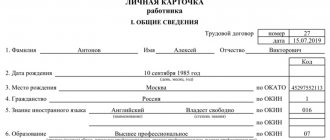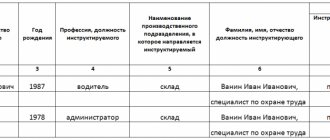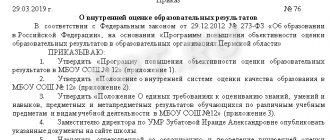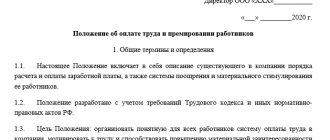Question from Victor:
Good afternoon. I work as an individual entrepreneur. The staff is small, 13 people. In occupational safety I am 0.01. Now a question about instructions. I would like to know what instructions should be provided to individual entrepreneurs on labor protection in 2020? Where is it stated that these instructions are mandatory? Thank you.
Reply to Victor:
Hello, Victor! First, you need to undergo training in labor protection at a training center (see Article 225 of the Labor Code of the Russian Federation), this way you will not only comply with the law, but also increase your competence in the field of labor protection. Regarding your question. Everyone, including individual entrepreneurs, must be guided by the Procedure for training in labor protection and testing knowledge of labor protection requirements for employees of organizations, approved by Resolution of the Ministry of Labor of the Russian Federation, Ministry of Education of the Russian Federation dated January 13, 2003 No. 1/29. The document is a normative legal act, i.e. the requirements contained therein are binding.
1.2. The procedure is mandatory for execution by federal executive authorities, executive authorities of constituent entities of the Russian Federation, local government bodies, employers of organizations regardless of their organizational and legal forms and forms of ownership, employers - individuals, as well as employees who have entered into an employment contract with the employer.
Labor protection for individual entrepreneurs
The article highlights the basic principles of organizing labor protection management in small enterprises (SE).
You will learn how to launch a labor protection system in a small enterprise step by step, how labor protection is organized for individual entrepreneurs who use hired labor, as well as those who do without it. The organization of labor protection in small enterprises is regulated by GOST R 12.0.009-2009
Occupational safety for individual entrepreneurs who hire workers is no different from occupational safety in small enterprises. Therefore, in the future we will talk about small enterprises.
Path 2: “hire a labor safety specialist on staff.”
The most common way is to have the problem resolved by a full-time specialist. Often, an employer thinks that by hiring a specialist, he will solve problems related to labor protection.
Let's look at the main pros and cons of this path
- a full-time specialist can quickly solve problems related to labor protection
Perhaps this is the only plus in this path. Why?
Let's look at the cons:
- if you have a small company, then having an occupational safety specialist on staff will significantly increase the burden on the company’s budget
- The labor protection specialist does not bear any responsibility for labor protection; the maximum penalty for violating labor protection requirements as an official is 15 thousand rubles. And penalties can be much higher. More about fines
- who will check the set of occupational safety measures carried out by the occupational safety specialist?
Introductory part
The legislation regulating the relations of citizens of the Russian Federation in the field of labor protection divides them into 2 categories: employers and employees. Employers are legal entities and individuals (IP) who hire workers to perform any work. Workers are the people who do these jobs. Each party is assigned a specific range of labor protection responsibilities.
The employer can be a large, medium or small enterprise, as well as an individual entrepreneur (IP).
All employers must provide safe working conditions and implement a set of labor protection measures for their employees. This must be done, even if there is only one employee. To do this, employers themselves or through authorized persons:
1. Create an OT system and ensure its effective operation.
2. Ensure the safety of production processes, buildings, equipment, materials, and workplaces.
3. Organize sanitary services for workers.
4. Organize the issuance of personal protective equipment (PPE), workwear, means for removing contaminants, and milk.
5. Provide methodological assistance to health departments: provide them with instructions, rules, regulations, magazines, help draw up lists for medical examinations, personal protective equipment, provide benefits, etc.
6. Organize training for workers and engineers, participate in knowledge testing commissions.
7. Conduct personnel training on occupational safety issues with the issuance of occupational safety certificates.
8. Organize mandatory medical examinations (preliminary, periodic, extraordinary, pre-shift).
9. Compile and submit labor safety reports.
10. Organize the investigation and recording of accidents (AC) and occupational diseases (OD), develop and implement measures that will avoid similar situations in the future.
11. Insure workers against accidents (AC) and occupational diseases (PD).
12. Develop rules, instructions, standards, and other safety documentation and bring them to the attention of employees.
Workers must:
1. Comply with safety requirements for your position or profession;
2. Use PPE, special clothing, and other protective equipment;
3. Complete occupational safety training and medical examinations on time and in full;
4. Immediately notify managers about dangerous work situations, deterioration of health, and accidents.
Development of documents on labor protection and fire safety
A number of small companies should develop a set of documents on labor protection and thereby solve all problems associated with outsourcing.
The main advantages of this path:
- The cost is an order of magnitude lower than hiring an occupational safety specialist or outsourcing one.
- Solving labor safety problems and avoiding fines.
Let's look at the cons:
- Labor protection legislation is constantly changing and the package of documents developed in the past may not be relevant after some time.
- If your company’s staffing changes and personnel gradation occurs, new employees are hired, the set of documents also changes, and accordingly, someone must be responsible for labor protection and maintain this set of documents.
Organization of labor protection in a small enterprise
Of course, the organization of occupational safety management in small and large enterprises is different. At the same time, the requirements are not weakened, but management links are simply lost. For example, 3-stage OT status monitoring is replaced by 2-stage. Features of the OT service depend on:
• number of employed workers; • areas of activity of the enterprise (this affects the lists of types of work, equipment operated, etc.).
If a small enterprise employs 50 or more people, a separate OT service must be created. This mainly applies to:
• transport, manufacturing and construction small enterprises with a staff of up to 100 people; • scientific, technical or agricultural enterprises employing up to 60 people.
If there are fewer workers, the organization of labor protection in a small enterprise is carried out by:
• employer (company manager, individual entrepreneur) personally; • authorized employee (a separate position of safety engineer or part-time position is being introduced); • third-party accredited specialists or organizations under contract.
A special standard is devoted to the organization of labor protection in small enterprises - GOST R 12.0.009-2009 . Labor inspectors, employees of the fire service, Energy Supervision and other departments are always ready to provide employers with a complete list of occupational safety documentation required by each specific enterprise.
Small business is one of the most important priorities for the development of the economy of any modern state, because It is this sector that accounts for the bulk of employment and production of goods and services in developed countries. According to the National Institute for Systematic Research on Entrepreneurship, today entrepreneurship in our country accounts for only 30% of the gross national product, while in Europe it is 70% or more. Therefore, it is no coincidence that in the Russian Federation much attention is paid to the problems of small business development, because Small and medium-sized businesses are associated with both the successful economic development of the country and the prospect of growth in the well-being of the population.
In accordance with the Federal Law of July 24, 2007 No. 209-FZ “On the development of small and medium-sized businesses in the Russian Federation,” which came into force on January 1, 2008, small enterprises, along with a certain structure of authorized capital, include enterprises with up to 100 people inclusive, regardless of the type of activity, of which micro-enterprises (with up to 15 people) are distinguished.
What problems does small business experience in terms of labor protection?
First, let's define the scale of the problem. According to the structure of distribution by type of economic activity, small businesses, as a rule, are represented mainly by enterprises in the field of service, trade and public catering, i.e. relatively safe activities. Meanwhile, in the structure of small business in Russia there is a fairly high share of those areas of activity that traditionally belong to the industries with the highest rates of injuries and occupational diseases - this is construction, transport and communications, manufacturing .
In the Irkutsk region, for example, the share of such enterprises, according to our estimates, is about a third of all small businesses. According to the Territorial Body of the Federal State Statistics Service for the Irkutsk Region, in 2010 the number of small enterprises (excluding micro-enterprises) in Irkutsk amounted to 3.5 thousand with a total number of employees of more than 100 thousand people. If we take into account the distribution of Irkutsk small businesses by type of economic activity, as well as the fact that in almost any of these enterprises violations in the field of labor protection are detected, then we can assume how large the proportion of workers who are at constant risk is - tens of thousands people in only one region. There are millions of such workers throughout the country. The authorities are doing a lot to boost private entrepreneurship in the country, including in terms of changing legislation. But any legislative decision has at least two sides. Liberalization of legislation is positive from the point of view of trade and freedom of enterprise, but on the other hand it increases the risk of violations of the labor rights of the weakest party in labor relations - workers.
On July 1, 2011, Federal Law No. 294-FZ of December 26, 2008 “On the protection of the rights of legal entities and individual entrepreneurs in the exercise of state control (supervision) and municipal control” comes into force. The law is aimed at easing administrative pressure on small and medium-sized businesses, imposes strict restrictions on the work of supervisory authorities, establishes a planned regime of inspections, in particular, the inspection plan for the coming year is agreed upon with the prosecutor's office and posted on the Internet in the public domain .
Thus, the employer knows in advance when and which control body will come with an inspection and, accordingly, has time to prepare in advance. This standard is aimed at conscientious employers to give them the opportunity, when preparing for an inspection, to bring their reporting and documentation on labor protection into compliance with state regulatory requirements.
Meanwhile, inspectors of state labor inspections of any region of the Russian Federation can give dozens of examples when, a month before the start of an inspection, an employer temporarily hires a labor protection specialist, and after the inspection, such a specialist is fired as unnecessary and all work on labor protection is stopped.
It is no secret that it is in small business organizations that work on labor protection is either not carried out at all, or is carried out from time to time, i.e. haphazardly. And this is most often revealed during the investigation of accidents, when it is too late to prevent anything .
It is obvious that the Federal Law “On the Protection of the Rights of Legal Entities and Individual Entrepreneurs in the Exercise of State Control (Supervision) and Municipal Control” should not limit the powers of labor inspectors granted to them by the provisions of Article 12 of ILO Convention No. 81 on Labor Inspection in Industry and Commerce , ratified by the Russian Federation back in 1998.
The problem of labor protection at the system level
According to the Ministry of Health and Social Development of Russia, most small enterprises do not have occupational safety services and specialists
, no work is being done to certify workplaces, funds are not allocated to provide workers with personal protective equipment, and periodic medical examinations are not carried out.
At the same time, the frequency rate of fatal occupational injuries in small businesses is almost 3.5 times higher than the national average
.
Massive non-compliance with labor safety requirements and lack of labor safety management at the system level is one of the most serious problems in our country, not only in the field of small business, but also in the economy as a whole. And to solve this problem, improving legislation alone is not enough. It is necessary to solve the problem at the system level, namely: the creation of a labor protection management system at the level of regions, territories and the companies themselves
.
In accordance with Article 216 of the Labor Code of the Russian Federation, regions must develop territorial targeted programs to improve working conditions and safety. We believe that it is in such targeted programs that specific labor protection tasks for small businesses should be defined (it is not from Moscow that labor protection in small enterprises in the regions of the country can be managed!) - this should become the direct responsibility of municipalities, to which regional authorities transfer part of the state powers on labor protection. One of the main strategic objectives of such territorial programs should be the creation of modern occupational safety management systems in small enterprises.
This is the only way to solve the problem of mass violations in the field of labor protection at the system level.
It is not by chance that most violations of labor safety rules are committed in the sphere of medium and small businesses. If in large companies and in corporations formed on the basis of Soviet enterprises, labor protection services have been preserved from earlier times, then small businesses do not have such baggage, and directors of small enterprises learn about the need to comply with labor protection requirements often for the first time during inspections.
It can be difficult for the head of a small enterprise to understand the complex legal and organizational issues of labor protection on his own, and he cannot afford to maintain not only a labor protection service, but even a labor protection specialist when he has only 3-4 employees. Article 217 of the Labor Code of the Russian Federation gives the right, if the employer does not have a labor protection service or a full-time labor protection specialist, to outsource their functions, i.e. involve an organization or specialist in a civil law contract
. But this type of service in Russia has not yet found mass application, since the market for services in the field of labor protection is still emerging and this is another problem for small businesses.
Occupational Safety and Health Training Programs for Small Businesses
Closely related to the listed problems is another, perhaps the main problem in our opinion in the field of labor protection - the problem of training in labor protection. According to Article 225 of the Labor Code of the Russian Federation, all employees, including heads of organizations, as well as employers - individual entrepreneurs, are required to undergo labor protection training and testing of knowledge of labor protection requirements.
In our opinion, it is in the process of such training that managers and specialists of small business organizations should receive the information and consulting assistance and knowledge they need
, as well as the required
set of educational, methodological and reference materials, specially developed and adapted for small enterprises,
including current regulatory legal acts on labor protection.
What is currently offered to small businesses in occupational safety and health training? Occupational safety training for managers and specialists of small businesses is carried out according to the Approximate Standard Occupational Safety and Health training program recommended back in 2004 by the Russian Ministry of Labor with corresponding curricula for 40 hours of training. In 2009, this Program was slightly revised by the Russian Ministry of Health and Social Development for the purpose of training certain categories of those insured under compulsory social insurance, which include representatives of small businesses.
What is the problem with training in such a Program? Firstly, the duration of training is 40 hours or five working days
– completely
unacceptable in a small business environment
.
Any training center will confirm to you that when enrolling in occupational safety training, company managers assume in advance that they are not able to attend all 5 days of training, since leaving their business for such a period is risky. Training centers, understanding the problem, make a compromise, allowing business managers to skip classes, arbitrarily shortening the training program for them
, but the result of such a compromise most often is
the lack of systemic knowledge of labor protection in the student.
Secondly, many of the topics proposed in the Program are too abstract, abstract in nature, while enterprise managers require specific, practical knowledge and only to the extent that they need in their daily work on managing occupational safety and health in their organization...
Deputy Director of the All-Russian Federation of the Federal State Unitary Enterprise "Research Institute TSS" of the Ministry of Health and Social Development of Russia L.M. Chernova
Organization of labor protection in a small enterprise step by step
To organize an effective labor protection system in a small enterprise, you need to step by step:
1. Create an OT service or appoint a person to perform its duties. This is formalized by order.
2. By order, appoint responsible persons (for fire safety, electrical safety, high-risk work, etc.).
3. Develop and approve by orders regulations on the occupational safety service, training, organization of hazardous work, monitoring the condition of occupational safety, development of instructions, fire safety, etc.
4. Create lists of professions and types of work for which there should be safety instructions. Develop and approve these instructions.
5. Draw up and approve programs for introductory briefings and classes on the fire-technical minimum.
6. Conduct training for all employees: workers and engineers.
7. Perform a special assessment of working conditions.
8. Organize and conduct medical examinations.
9. Create a commission on occupational safety.
10. Invite employees to select occupational safety representatives and train them.
11. Develop, approve and place evacuation plans in places accessible to employees.
12. Create and organize journaling:
• induction training; • briefings at workplaces; • accounting and verification of fire extinguishers; • checking tools and devices; • accounting of NS and PP; • inspections; • recording cases of domestic injuries; • issuing instructions; • issuance of personal protective equipment; • others.
13. Organize sanitary services.
14. Organize the issuance of personal protective equipment, means for removing contaminants, and milk (if necessary).
15. Get visual propaganda: instructions, diagrams, posters, stands.
Further organization of labor protection management in small enterprises depends on the specifics of their activities. Let us note that labor protection should not just be properly organized in “paper” form, but work in practice every day. Instructions must be conducted, operational control carried out, planned activities implemented, unscheduled inspections organized, etc.
The costs of labor protection for individual entrepreneurs and small businesses can be significantly reduced at the production planning stage. To do this you need:
• Choose office, warehouse, industrial, and retail premises that have already been put into operation (there are commissioning certificates, acceptance certificates by state commissions, etc.), have passed special inspections, are equipped with warning systems, fire extinguishing systems, and have suitable sanitary and living conditions.
• Plan a special assessment of working conditions. It can be done in stages, attracting funds from the Social Insurance Fund. It must be remembered that when moving production or office, the special assessment will have to be carried out again. But for homeworkers and workers who work remotely, it is not carried out at all.
• Organize the purchase of workwear, personal protective equipment, and detergents in bulk.
• Conduct training for workers in special centers in groups, rather than individually, so that discounts can be claimed.
• Purchase foreign-made equipment that has already passed all the necessary checks, examinations and is equipped with the appropriate certificates.
• Try to stipulate in equipment rental agreements that the lessor is responsible for its verification and routine inspection.









